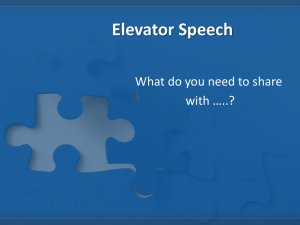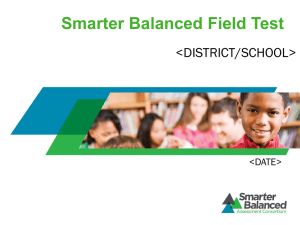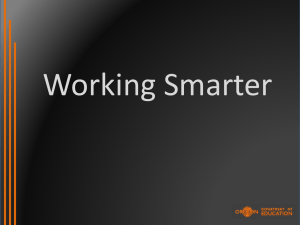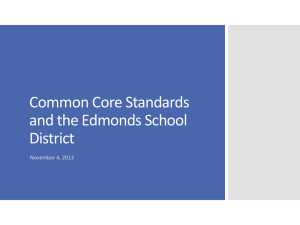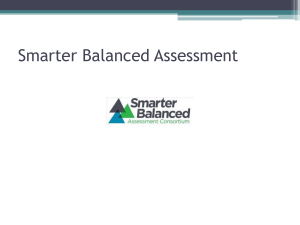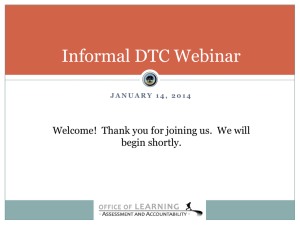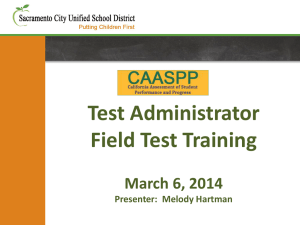Smarter Balanced Field Test Fact Sheet
advertisement
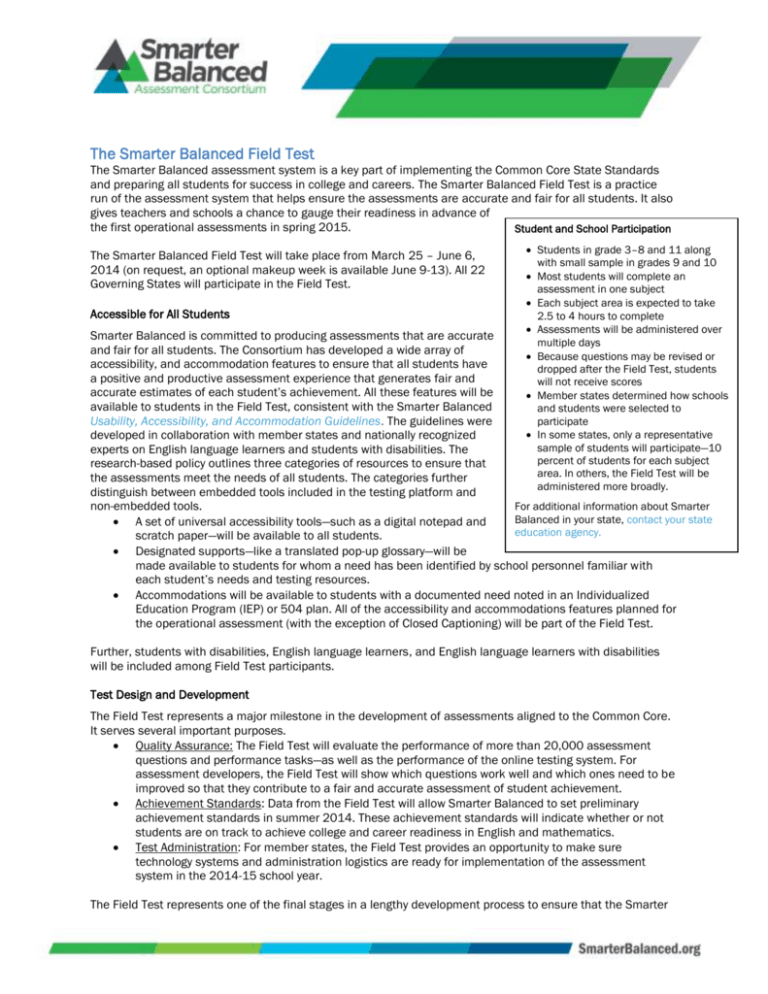
The Smarter Balanced Field Test The Smarter Balanced assessment system is a key part of implementing the Common Core State Standards and preparing all students for success in college and careers. The Smarter Balanced Field Test is a practice run of the assessment system that helps ensure the assessments are accurate and fair for all students. It also gives teachers and schools a chance to gauge their readiness in advance of the first operational assessments in spring 2015. Student and School Participation The Smarter Balanced Field Test will take place from March 25 – June 6, 2014 (on request, an optional makeup week is available June 9-13). All 22 Governing States will participate in the Field Test. Accessible for All Students Students in grade 3–8 and 11 along with small sample in grades 9 and 10 Most students will complete an assessment in one subject Each subject area is expected to take 2.5 to 4 hours to complete Assessments will be administered over multiple days Because questions may be revised or dropped after the Field Test, students will not receive scores Member states determined how schools and students were selected to participate In some states, only a representative sample of students will participate—10 percent of students for each subject area. In others, the Field Test will be administered more broadly. Smarter Balanced is committed to producing assessments that are accurate and fair for all students. The Consortium has developed a wide array of accessibility, and accommodation features to ensure that all students have a positive and productive assessment experience that generates fair and accurate estimates of each student’s achievement. All these features will be available to students in the Field Test, consistent with the Smarter Balanced Usability, Accessibility, and Accommodation Guidelines. The guidelines were developed in collaboration with member states and nationally recognized experts on English language learners and students with disabilities. The research-based policy outlines three categories of resources to ensure that the assessments meet the needs of all students. The categories further distinguish between embedded tools included in the testing platform and non-embedded tools. For additional information about Smarter Balanced in your state, contact your state A set of universal accessibility tools—such as a digital notepad and education agency. scratch paper—will be available to all students. Designated supports—like a translated pop-up glossary—will be made available to students for whom a need has been identified by school personnel familiar with each student’s needs and testing resources. Accommodations will be available to students with a documented need noted in an Individualized Education Program (IEP) or 504 plan. All of the accessibility and accommodations features planned for the operational assessment (with the exception of Closed Captioning) will be part of the Field Test. Further, students with disabilities, English language learners, and English language learners with disabilities will be included among Field Test participants. Test Design and Development The Field Test represents a major milestone in the development of assessments aligned to the Common Core. It serves several important purposes. Quality Assurance: The Field Test will evaluate the performance of more than 20,000 assessment questions and performance tasks—as well as the performance of the online testing system. For assessment developers, the Field Test will show which questions work well and which ones need to be improved so that they contribute to a fair and accurate assessment of student achievement. Achievement Standards: Data from the Field Test will allow Smarter Balanced to set preliminary achievement standards in summer 2014. These achievement standards will indicate whether or not students are on track to achieve college and career readiness in English and mathematics. Test Administration: For member states, the Field Test provides an opportunity to make sure technology systems and administration logistics are ready for implementation of the assessment system in the 2014-15 school year. The Field Test represents one of the final stages in a lengthy development process to ensure that the Smarter Balanced assessment system measures the depth and breadth of the Common Core State Standards. Over the past two years, working with K-12 teachers and higher education faculty, Smarter Balanced member states developed, reviewed, and tested thousands of assessment questions and performance tasks. In 2013, Smarter Balanced conducted a Pilot Test in 5,000 schools across the country with 650,000 students. Information from the Pilot Test informed the development of additional assessment items and performance tasks, accessibility options and accommodations, and the design of the assessment interface. Technology Requirements The Smarter Balanced Technology Strategy Framework and Testing Device Requirements provide minimum hardware specifications and basic bandwidth calculations that will allow schools and districts to evaluate how best to support the administration of the assessment system in the 2014-15 school year. The framework was developed with input and feedback from Smarter Balanced member states, work groups, and data from the Technology Readiness Tool, an online inventory of school technology resources launched in 2012. Based on the research and data analysis, Smarter Balanced estimates that the majority of schools and districts in member states will be able to successfully administer the assessments with their existing infrastructure. Practice Test and Training Test The Practice and Training Tests are available to schools and districts for student orientation and preparation, professional development activities, and for discussions with parents, policymakers, and other interested stakeholders. Both resources will help teachers and students prepare for the spring 2014 Smarter Balanced Field Test Practice Tests Available since May 2013, the Smarter Balanced Practice Tests allow teachers, students, parents, and other interested parties to experience a full grade-level assessment and gain insight into how Smarter Balanced will assess students’ mastery of the Common Core. The practice tests include a variety of items (approximately 30 items each in ELA and math) as well as an ELA and math performance task at each grade level (3–8 and 11). Training Tests The Training Tests were designed to provide students and teachers with opportunities to quickly familiarize themselves with the software and navigational tools that they will use on the upcoming Smarter Balanced Field Test. The Training Test includes all new item types organized by grade bands (grades 3 to 5, 6 to 8, and high school) that will be available on the Field Test and the full suite of accessibility and accommodations features. Students and teachers can now access all accessibility and accommodations resources that will be available on the Field Test, including American Sign Language (ASL) videos for all listening items. The Training Test serves as a complement to the Practice Test and includes the following features: Training tests are available by grade band (grades 3-5; 6-8 and high school) There are approximately 14-15 items per grade band (in ELA and math combined) New item types, not previously included in the practice test, are featured The training test does not include performance tasks All accessibility and accommodations features planned for the spring 2014 Field Test and 20142015 operational tests are included. The Practice Test and Training Test are available on the Smarter Balanced Field Test Portal at http://sbac.portal.airast.org/practice-test/. Training Modules The Smarter Balanced Field Test Portal provides test preparation Training Modules available for test administrators, teachers, and students. Among the modules available are: The What is a Field Test module was designed to help students understand what a field test is and why it is important for students to participate in the Smarter Balanced Field Test. The Let’s Talk Universal Tools module was developed to acquaint students and teachers with the universal tools available on the test. The Accessibility and Accommodations Training Module outlines the recommended uses of designated supports, available universal tools, and other accommodations for student accessibility to the assessments. These Training Modules and more are available at: http://sbac.portal.airast.org/field-test/resources/
